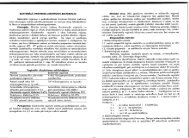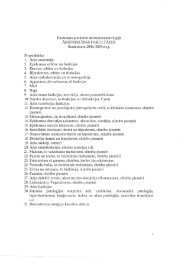PHYSICS
n - susliks.lv
n - susliks.lv
- No tags were found...
Create successful ePaper yourself
Turn your PDF publications into a flip-book with our unique Google optimized e-Paper software.
Distant objects<br />
Near objects<br />
1<br />
2<br />
2<br />
u<br />
20<br />
3 ----l'>i «:<br />
3<br />
3<br />
4<br />
4<br />
6<br />
4<br />
a<br />
h<br />
5<br />
Fig. 22.4. Sections of the eyes of various birds:<br />
a - buzzard (Buteo); b - owl (Strigiformes). Main elements of the<br />
eyes: 1 - cornea; 2 - aqueous humor; 3 - sclerotical ring; 4 <br />
sclera; 5 - choroid; 6 - retina; 7 - fovea centralis; 8 - fovea lateralis;<br />
9 - pecten; 10 - vitreous humor; II - lens; 12 - bulging ring<br />
of lens; 13 - ciliary muscle; 14 - pectinate zone; 15 - suspensory<br />
ligaments; 16 - iris; 17 - conjunctiva; 18 - palpebra interior; 19<br />
membrane nicticans; 20 - canaliculus lacrimalis; 21 - glandula<br />
nicticans; 22 - glandula lacrimalis; 23 - optic nerve<br />
blood supply to the retina, thereby reducing the number of blood<br />
vessels in the retina. Fewer blood vessels reduce the scatter of<br />
light coming into the eye, improving vision. For predatory birds,<br />
their vision has evolved to be the sharpest in the animal kingdom.<br />
Interestingly, birds may be able to perceive ultraviolet and nearultraviolet<br />
light, which humans cannot.<br />
Fish. The optical system in fish is similar to that of land<br />
vertebrates; however, there are some important differences. Fish<br />
have a more spherical shaped lens and focus by changing the<br />
relative distance between the lens and the retina (fig. 22.5). Certain<br />
other vertebrates focus by changing the curvature of their lens<br />
which is flexible. Fish also have choroids that contain a special<br />
structure, the tapetum lucidum, which contains very reflective<br />
guanine crystals. The crystals aid their vision in dim light.<br />
162<br />
~.<br />
"<br />
~<br />
~<br />
Fig. 22.5. The eye of a Bony Fish:<br />
1 - spectacle; 2 - scleral layer<br />
of cornea; 3 - true cornea; 4 <br />
lens; 5 - iris; 6 - suspensory<br />
ligament of lens; 7 - annular<br />
ligament; 8 - falciform process;<br />
9 - refractor muscle of lens;<br />
10 - retina<br />
Fig. 22.6. Compound eye of a<br />
Honey Bee. a - structure of a<br />
compound eye: 1 - cornea;<br />
2 - crystalline cone; 3 - rods of<br />
a retina; 4 - optic nerve; b -<br />
a single ommatidium of a compound<br />
eye: 1 - crystalline lens; 2 <br />
crystalline con; 3 - pigment cell;<br />
4 - retinal cell (rhabdom);<br />
5 - pigment cell<br />
It should be noted that water is not a good visual medium due<br />
to its attenuation and refraction of light.<br />
Insects. The compound eyes of most insects consist of many<br />
separate visual elements called ommatidia (fig. 22.6). The receptor<br />
cells within the ommatidium each detect a very small fraction of<br />
the spectrum of light that passes through narrow channels called<br />
rhabdomeres. Rhabdomeres give the eye its faceted appearance.<br />
22.2. DEFECTS OF VISION<br />
Because of the complexity of the eye, certain defects often<br />
arise that can cause impaired vision.<br />
Short-sight (Myopia). A short-sighted person can see nearby<br />
objects distinctly, but not distant ones. With the latter, objects<br />
focus in front of the retina due to the eyeball being too long<br />
163






